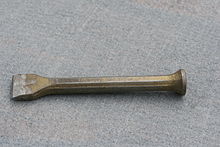Punch (tool)
The cutting iron is a historical tool that is still used today in stone processing.
use
This is a tool made of steel, which has a hardened wedge-like cutting edge and an unhardened shaft. The cutting width of a cutting tool is approx. 20 to 25 mm. The cutting edge can consist of hard metal . The end of the tool is designed either as a stud head for soft rock or as a hammer head for hard rock processing.
Chisels are driven with the help of a hammer or a club in order to hit the rough natural stone on the rough and unworked stone surfaces . First, three outer edge strokes are carried out, which then offer the possibility of creating a flat surface with a fourth stroke. The fourth point on the stone surface can be seen with the eye and with the help of a straightedge after three measuring points have been created with the two edge strokes. Only then does a flat surface emerge, which offers the starting point for further stone carving work , such as B. the production of a cuboid. Then the stone material protruding between the blows is worked off with other tools so that the surface is flat.
Similar tools
jobs
literature
- Reiner Flassig: Historical stone processing. In: Training center for the stonemasonry and sculptor's trade (ed.): Steinmetzpraxis, The manual for daily work with natural stone. 2nd, revised edition. Ebner Verlag, Ulm 1994, ISBN 3-87188-138-4 , p. 310 ff.
- Karl Friedrich: Stone processing in its development from the 11th to the 18th century. Filser, Augsburg 1932.
- Peter Völkle: Work planning and stone processing in the Middle Ages . Ebner Verlag, Ulm 2016, ISBN 978-3-87188-258-6 .

